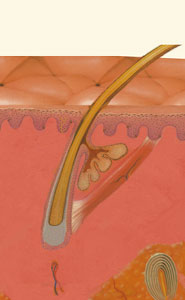How does hair grow?
A hair consists of a shaft and a root. The shaft is visible above the surface of the skin and the root is buried beneath. Hairs pass through various stages of a growth cycle including anagen (active hair growth), telogen (resting phase) and catagen (where the hair falls out). The length of the cycle varies from one region of the body to another.

Anagen

Catagen

Telogen
How does the treatment work?
Lasers and IPLs deliver a short pulse of light onto the skin’s surface. The light energy is converted into heat within the hair follicle. Heating the follicle prevents further regrowth of the hair. Lasers emit high energy at one specific wavelength (colours) in a single beam of light. Intense pulse light (IPL) is broadband light energy that delivers hundreds of wavelengths (or colors) in a single discharge. Providing the hair is in its growth stage (anagen) the heat can be transferred down the hair shaft to the base of the follicle, damaging the germination centre responsible for its regrowth.
How many treatments are needed?
On average 6 to 8 treatments are needed at 6 to 10 week intervals. The exact number of treatments required depends on several factors including hair colour, skin colour, hair density and the site of hair growth.
Can all hair colours be treated?
Lasers and IPL work highly effectively on dark hair because the pigment melanin absorbs the laser light. Fair hair can respond well, but white hair, grey hair, very blond hair and red hair responds poorly to lasers and IPL’s.
Can all parts of the body be treated?
We are able to treat all areas of the body safely, quickly and effectively.
Is the treatment permanent?
The permanence of laser hair removal is often questioned. In practice no single laser system destroys all hair follicles. Some follicles are destroyed, others are miniaturized and some enter a prolonged resting phase. It is possible that with a sufficient number of treatments, true permanent hair removal can be achieved.
What other treatment methods are available?
There are a number of traditional methods of removing unwanted hair; shaving, plucking, waxing, depilatory creams and electrolysis – all of which can be painful, time consuming or only temporarily effective.
Is the treatment painful?
By utilizing refrigerated cold air directed over the skins surface during the procedure we ensure that most patients experience no more than a mild stinging sensation.
Are their any after-effects following treatment?
Redness, and some discomfort of the area (like sunburn) may be present for the first few days following treatment. Blistering may occur in a small minority of patients, and this settles without treatment in a few days. Rarely, the pigment in the skin may be affected resulting in the treated area appearing lighter or darker. This usually settles in time.
Who performs the treatment?
Our expert medical team has in excess of 30 years laser experience and have completed more than 150,000 successful treatments. Rest assured you are in safe hands. All procedures at our Cambridge Laser Clinic are performed by fully qualified doctors, nurses and practitioners.
To ensure the highest ethical standards are maintained at all times, our staff are never offered bonus incentives to sell treatments.
Is laser treatment safe?
There is no evidence whatsoever to suggest that laser treatment can lead to skin disorders or an increased risk of skin cancer. Our lasers are fully cleared by the American Food and Drug Administration (FDA) and have full CE clearance in Europe.
Although medical laser clinics are no longer regulated by the CQC (Care Quality Commission), we continue to adhere to the strict standards that were in the past mandatory under government legislation. This is the best indicator currently available that our Cambridge Laser Clinic is trustworthy.
All consultations are free of charge so why not call our team of experts today?
